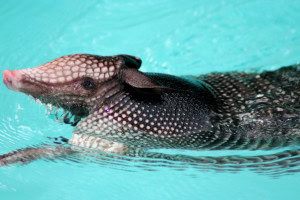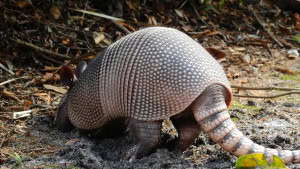The first time I had ever seen an armadillo in person was back in 2008. I was amazed, because I thought that they were primarily a Texas animal. I initially thought that it was a fluke. That is, until a few weeks later when I saw another one. That made me wonder if they had been displaced because of Katrina.
Since then, I have seen many of these little critters, but didn’t think too much about it until recently. Take a guess why I am paying more attention to these giant rolly pollies. If you guessed that they were invading my yard, then you win the prize!
They dig and dig, and then dig some more. Just when I thought that I was getting a handle on how to deal with all the deer, now I have had to figure out the problem with the armadillos. Hopefully, what I have found will help any one else out there searching for a solution.
According to scientist, they had already expected the armadillos to make their way into Tennessee, but they had not expected them to move in as fast as they did. From what I could find, they have been in Georgia and Alabama since at least the early 70s, and first appeared in Tennessee in the 80s. They were expected to expand at around 4 miles per year, but so far they have waddled their way several hundred miles ahead of schedule. So, I guess it wasn’t Katrina, but I wouldn’t be surprised if that sped things along.

At one time, scientist thought that the Tennessee River would help to hold them back, or at least slow them down. I guess they didn’t figure on the armadillos wonderful ability to swim. As you can see, they will even take a dip in the pool, if you have one. Which creates a problem of its own – as if their giant holes weren’t enough.

They generally will come out just after dark to search for food. I have read that the younger armadillos make an appearance early in the morning. ( I must have armadillos of all ages).
They are not territorial by nature, nor are they very concerned with their surroundings, as you can see by this hard at work armadillo (who didn’t even seem to mind having his photo taken). They follow their sense of smell, which is why they like to dig in some lawns but not in others. If you have grubs beneath the ground, they are determined to dig them all out. They also eat worms and other soft bodied creatures. ( A neighbor of mine once had new sod laid, only to wake up each morning to find it rolled back up, as if it had never been unrolled. She would roll it back out, and at night the armadillos would come and roll it back up again. This went of for a few weeks, until the armadillos decided that they had eaten all of the available worm). :-)
How to Deal with Armadillos
(Disclosure: I am including a few affiliate links here for your convenience. You can read more about that here.)
So, “how do I get rid of them” you say. Well, there are several methods that can work. No, I won’t be recommending killing them. I am truly frustrated with the little buggers, but I also know that they are just searching for food. I will let you decide if your problem warrants anything so severe.
But with a little effort, armadillos can be controlled. Some of the methods that I have discovered that some people use – such as repellants or hot sauce – I passed on after researching what scientist have to say.
Mothballs
One other method that I found to be iffy – moth balls – I also passed on. However, I can see how this might work. Since armadillos function by smell, it stands to reason that a strong chemical smell could serve as a deterrant. However, I have heard of people dropping the moth balls into an armadillo’s burrow, only to have the armadillos kick them back out. And if they are smart enough to roll up sod, I figured that they would find their way around mothballs.
Fencing

The only way to keep them from ever getting into your yard is to have a good fence in place. The fence would ideally need to be at least 2′ below the soil line to keep them from digging under. However, I can say that I have not seen any trace of them inside my fenced in area, which is just a wrought iron fence. But they, are very active in the unfenced areas.
Traps


Lawn Treatments
From time to time, I have come across someone who will recommend using a pesticide to kill off the grubs. While, I did in fact treat for grubs, because they cause their own amount of damage, it is important to know that it is impossible to prevent armadillo damage by using a pesticide. 1) There is no way to safely kill off all of the worms, and 2) you wouldn’t want to, even if you could. Worms are vital to a healthy lawn. Most people struggle to attract them to their yard. So, I wouldn’t recommend trying to handle the armadillo problem by using pesticides. That will just cause other problems. However, it can be helpful to remove a food source such as grubs, if you know that this is a particular favorite for the armadillo.
Clean up or relocate wood piles

Try to keep known worm and grub attractors on the outskirts of the lawn. Wood piles are a perfect example. They are breeding grounds for armadillo food. If at all possible, move the piles away from any area where you do not want the armadillos to venture. At the very least, it may provide them enough food to keep them happy without digging through your well maintained lawn.
Mulch

Try replacing the soft mulch with something a little less easy to dig through. Decorative gravel or rocks can serve a deterrent in some cases. Also, mulch provides food for worms, and as such creates food for the armadillo. It’s not going to rid your entire lawn of the problem, but it can help if they are destroying a specific area.
Castor oil

Using this particular method will require persistence. It is not a one time treatment. You will need to treat your lawn at least 1x per month during the armadillo’s digging season. (for me that is in the Fall). More treatment may be required if you are having a rainy patch. But eventually, the armadillo will begin to associate the stomach issues with your lawn, and then they will start to avoid it in favor of your neighbor’s. This product can be purchased through Amazon, as well.
Who Let the Dogs Out

One other thing that you can do to help deter armadillos from invading your lawn, if you have a dog, let it out. Just after dark for a couple of hours and again very early in the morning. Even though they seem to care less if I walk up on them, they take off very quickly when a barking dog is barreling down on them. (Although I am not sure how good this dog would be at lawn patrol). ;-)
Final Thoughts
So, what ways have you found to deter armadillos? Drop a comment and let the rest of us know.
Feature image courtesy of Chris Van Dyck. Some images in this article are licensed by Creative Commons.




Please keep it clean. Comments that do not follow the Comment's Policy may be removed.